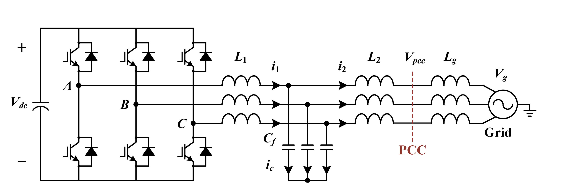ABSTRACT
Active damping and harmonic compensation are two common challenges faced by LCL-filtered voltage source converters. To manage them holistically, this paper begins by proposing a virtual RC damper in parallel with the passive filter capacitor.
The virtual damper is actively inserted by feeding back the passive capacitor current through a high-pass filter, which indirectly, furnishes two superior features. They are the mitigation of phase lag experienced by a conventional damper and the avoidance of instability caused by the negative resistance inserted unintentionally.
Moreover, with the virtual RC damper, the frequency region, within which the harmonic compensation is effective, can be extended beyond the gain crossover frequency. This is of interest to some high-performance applications, but has presently not been achieved by existing schemes. Performance of the proposed scheme has been tested in the laboratory with results obtained for demonstrating stability and harmonic compensation.
SYSTEM DESCRIPTION

Fig. 1. Three-phase grid-connected voltage source converter with an LCL filter
Fig. 1 shows a three-phase grid-connected voltage source converter with an LCL-filter, whose parameters used for design are summarized in Table I. For simplicity, the dc-link voltage Vdc of the converter can be treated as constant, while its grid synchronization bandwidth can be assumed as smaller than the grid fundamental frequency to avoid unintentional low-frequency instability. This structure has earlier been shown by to have an inherent damping effect even when only a single control loop is used for regulating the grid current i2.
The only condition demanded is for the LCL resonance frequency to be placed above one-sixth of the system control frequency fs/6, which in, is named as the critical frequency. This region is however not attractive because of its poorer switching harmonic filtering, which in general, compromises the purpose of having an LCL filter. Moreover, the wide variation of grid impedance in weak grids may shift the LCL resonance frequency in a wide spectrum across fs/6, giving rise to instability if no external active damping is employed.
PROPOSED VIRTUAL RC DAMPER
Transfer function of the resulting RC damper in the synchronous frame is thus given by the second expression in (11), whose implementation involves cross-coupling, and is hence more complex like shown in Fig. 11. Realizing and analyzing the damper in the stationary frame is thus generally recommended because of simplicity.

SELECTIVE HARMONIC COMPENSATION
Selective harmonic compensation is performed by placing resonant peaks at frequencies identified for compensation. It can be performed in the synchronous or stationary frame. For the latter, multiple resonant controllers are commonly used, which for L-filtered converters, have been proved to compensate for harmonics up to the Nyquist frequency, after introducing the necessary discretization and phase compensation. The resulting discretized resonant controllers are described next, before discussing how their harmonic compensation frequency range should be chosen for LCL- filtered converters.
EXPERIMENTAL RESULTS
To verify the analysis presented, the LCL-filtered converter shown in Fig. 1 is implemented and connected to a California Instruments MX-series ac power supply for emulating the grid. Parameters chosen for the converter were listed in Table I, from which parameters summarized in Table II are designed for the RC damper and resonant current controllers, following the discussion presented in the paper. The resulting control scheme is realized with a dSPACE DS1006 system, whose produced results are explained as follows.
A. Active Damping
B. Selective Harmonic Compensation

Fig. 19. Measured per phase PCC voltage and grid current with high cutoff frequency for the virtual RC damper
CONCLUSION
This paper presents a holistic analysis of active damping and selective harmonic compensation for LCL-filtered, grid- connected converters. Experimental results obtained show that the proposed virtual RC damper dampens LCL resonance well with the instability influences, caused by the system delays, mitigated promptly. The damped system, in turn, allows the harmonic compensation to be extended until LCL resonance, rather than the gain crossover frequency. This expectation has been verified by three experimental cases, in which the highest resonant terms have been placed close to their respective LCL resonance frequencies. Appropriate design guidelines are also given, which upon being followed, results in converters with a better robustness and the less harmonics even if the grid inductance varies widely.
Source: IEEE
Authors: Xiongfei Wang | Frede Blaabjerg | Poh Chiang Loh
>> Simple Matlab Projects Base Papers for Engineering Students
>> Best Matlab Project Ideas for Engineering Students with Full Project Materials
>> Simulink Projects using Matlab for Engineering Students
>> 200+ Matlab Projects based on Control System for Final Year Students
